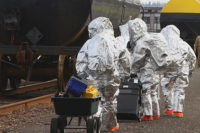Armed with the wealth of information uncovered by the IH community, organizations have most of the critical information needed to implement effective training programs. Still, in order to ensure training is implemented beyond the classroom, managers need to understand and address human behavior.
Behaviors are, indeed, behind conditions such as air and noise pollution, and ergonomic strain. Some conditions exist because management has provided chemicals and tools that produce or control contaminants. In other scenarios, contaminants are released by the way an employee performs a task.
The goal in training is to increase the worker's percentage of knowledge that gets converted into action. For instance, it's not enough for workers to understand how to correctly complete an MSDS sheet; training must ensure they will read it at the appropriate time. The key to an effective training program is helping participants make desired changes easily and comfortably.
Two simple options
So how can trainers influence executive behaviors such as studying TLV guidelines or employee behaviors like using respirators for small jobs? There are essentially two options: either increase the fear factor or increase fluency. Even though IH trainers must inform managers and employees about hazards, a fear-based training strategy will likely produce only a short-term effect at best and may increase the very behaviors the training is intended to reduce.The alternative strategy focuses on fluency - the ongoing use of a behavior. Using this strategy, lectures are kept to a minimum and practice is the priority. Participants are given a chance to use their knowledge in the training room or in the workplace, so desired changes become habitual.
Professionals in the behavioral sciences have discovered that in order to make desired changes habitual, workers must practice incorporating newly introduced behaviors on a regular basis. And while traditional classroom training can deliver great value, often the most effective, results-oriented training takes place outside of a formal classroom setting. By conducting training sessions at the location where desired activities will ultimately take place, likelihood of compliance is often greatly increased.
Ten effective drills
The following are examples of recommended training scenarios, many of which can (and should) be implemented both inside and outside of the classroom.1) Give the group a list of tasks, each of which should begin with examining the MSDS sheets (which should be prepared and accessible), and ask them to demonstrate the first three steps of the task. Structure this process as a competition between the two groups to increase participation. Each group receives points if they begin by pulling up the MSDS sheets, but must start over if they do not.
2) Ask the maintenance staff to list steps to modify various pieces of equipment. To build fluency, ask them to identify the previous use for each piece of equipment. This will help them avoid scaling a hazardous chemical such as cyanide because they didn't know that a piece of equipment was once used as a container for the poison. Unless employees are trained to raise such questions, they will continue to be at risk of exposure to deadly contaminants.
3) Give a group of executives or hourly employees a map of the facility. List chemical exposure incidents and ask them to locate the nearest first aid station equipped to address that specific problem.
4) Where heliarch welding is performed, ask workers to practice setting up a warning sign before welding and taking it down when finished. Both steps are necessary since a sign that does not accurately describe a danger will be quickly ignored.
5) Place various pieces of PPE in a box. Display a series of hazard placards and ask the group to practice pulling out the right pieces of PPE for each hazard.
6) Drill on the correct first aid procedures participants should use if they found a coworker suffering from certain injuries or exposures. Reinforce all correct answers and address any incorrect answers as constructively as possible.
7) Practice evacuation drills on an intermittent basis with individuals or groups, including managers. Post-evacuation, regroup and assess what was done correctly and what needs improvement.
8) Ask workers to practice stretching to alleviate back strain incurred after working in a static position for a long period of time. Have employees resume working in the static position, and in a reasonable amount of time-practice the stretches again.
9) Visit various departments and ask what steps someone would take to ensure his safety. Reinforce all positive responses, and point out all desired responses the employee may have missed. (Focus on tasks such as working in confined spaces, and reinforce proactive behaviors such as monitoring for air quality.)
10) Have workers repeatedly practice using their computers with their wrists in a neutral position.
Practice makes perfect
Ongoing practice and drills not only build fluency but also increase the opportunity to positively reinforce desired behaviors. This, in turn, accelerates the process of forming good habits. By engaging in activities that can be positively reinforced and not just sitting passively, workers overcome fears, concerns and disbelief. As a result, they ultimately move towards acceptance.By understanding and addressing human behavior in training, corporations will increase the level of acceptance and implementation, and ultimately increase worker safety beyond expectations.

